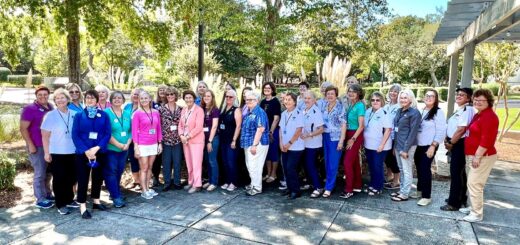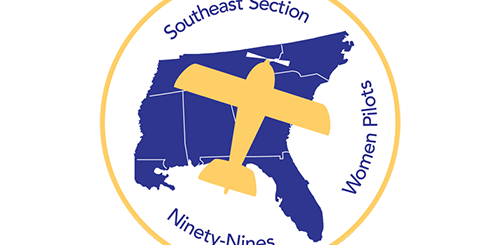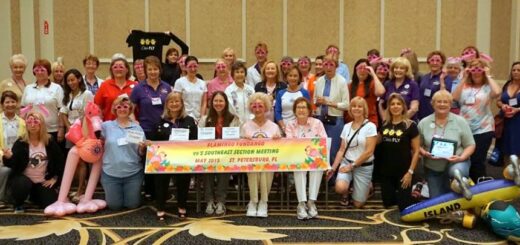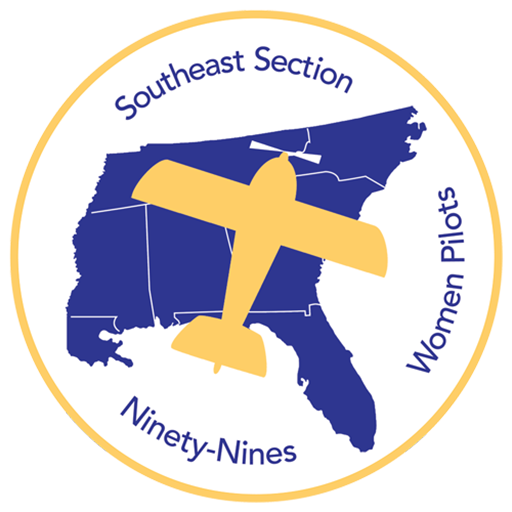2013 Fall Section Meeting
Hunting for Hurricanes in Biloxi | Mississippi Chapter | Sept 26-29, 2013
2013 Fall SE Section Meeting Minutes
Written by Erin Seidemann (www.agirlandherplane.com)
Anyone who knows me knows that I would give a female reproductive organ (or what’s left of mine) to ride in a C-130. It’s my favorite big plane. Yes, I had to break down my favorite airplane into two categories because who could possibly name one favorite airplane? So I have a favorite big plane and a favorite little plane…well…and maybe a favorite plane of the week…if not of the day. Anyhoo, the C-130 Hercules is it. The sound. The size. The things that can fit into it. If you don’t know what a C-130 is but you’ve seen the Blue Angels performing at airshows, it’s the big transport airplane they use. The Blue Angels’ one, flown by Marines, is called Fat Albert and even has JATO (jet-assisted take-off) to make it even cooler. I’ve nearly driven my car up a light pole on multiple occasions when I see a C-130 fly by.
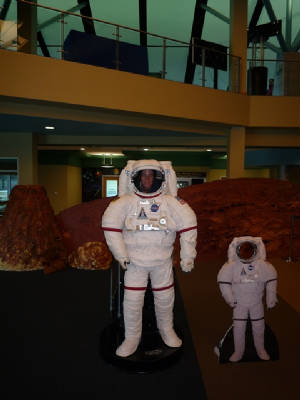
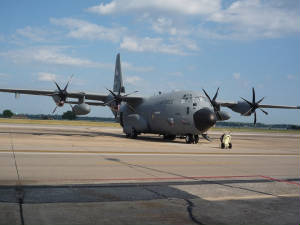
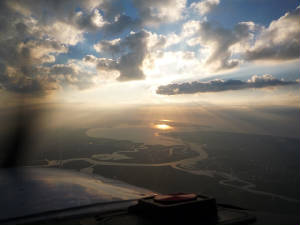
So when I got the itinerary for the Southeast section meeting of the 99s (the international organization of women pilots started by Amelia Earhart and 98 other women pilots http://www.ninety-nines.org/) and it said we’d get to climb around a C-130, let’s just say it’s a good thing I have high ceilings or I would have hit my head. But that’s not all! It also said you could choose to fly into either Gulfport airport (KGPT; landed there, done that) or a private grass strip called Shade Tree Airport (http://www.shadetreeairport.com/) owned by one of the 99s and her husband. Ooh! Private! Grass! Strip! I signed up faster than whatever the Southern equivalent of a New York minute is! So I’d have to get up super early after working super late the night before. Small price to pay for a C-130.
I had my alarm set for 5:45. I used to get up even earlier than that all the time when I worked the early morning shift. But it’s funny how quickly being on the night shift makes one forget about things like the sun might not be up at that hour. It was totally dark when I looked outside, and only then did I think to check the sunrise time online to see if it would even be light for my 6:45 departure. Teensy little minor detail there. I did get to enjoy the beautiful sunrise on the way there, making it difficult to see much, but it was pretty anyway.
Flying into a grass strip is pretty different than flying to a paved runway airport. You can typically see paved runways from miles away. But grass strips look like any other patch of grass. I had checked out Google maps beforehand hoping to find some landmarks that would help me find it. Well, there was grass, and trees, and some small ponds, and more grass, but nothing that looked any different from the adjacent grass, trees, and small ponds. So I knew I’d have to rely pretty heavily on my GPS and just keep zooming it in more and more as I got closer to make sure I didn’t fly past it. When you are talking to an approach controller, they want you to let them know when you have your landing field in sight. And if you forget to do that, they’ll kindly remind you with something like “November Five Niner Zero Sierra Papa, the airport is at your twelve o’clock and six miles,” which is exactly what my controller said to me. I replied, “Zero Sierra Papa, I’m gonna have to get a lot closer than this to see it!” How far away was I when I finally saw it? About 50 feet thanks to the tall trees that surrounded it on all sides. Not long enough to set up a stabilized approach, but I knew I’d have to overfly the runway anyway to check out the windsock so I could figure out which way to land. The wind was favoring the direction I had come from, so I needed to make a traffic pattern to come back around to land. I flew the upwind leg, turned 90 degrees to fly the crosswind leg, checked back out the window to make sure I didn’t lose sight of the airport, turned another 90 degrees for downwind…and lost it. Well, that’s the beauty of flying a good rectangular traffic pattern: I knew I’d find it again on base or final. The first notch of flaps when I figured I was somewhere near abeam what would be the runway numbers if the grass had runway numbers, turn base and put in another notch of flaps, still, no airport, turn final and there it is! Dump full flaps, figure out if I can make it safely, check my airspeed since I wanted to land a little slower than on a paved runway, and put it down for its first grass landing since I moved back from California. I was gingerly slowing down as I didn’t want to jam on the brakes and get stuck if there was a soft spot, and just as I was about to slow enough to turn around, there was a downslope to the runway. Well, I’m in no hurry, so I was patient. Once I slowed down enough to turn around, I could see my tracks in the grass, still wet with morning dew. Ahhhhhhh. What a beautiful sight for a pilot!
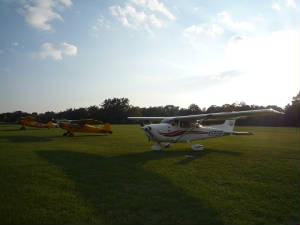
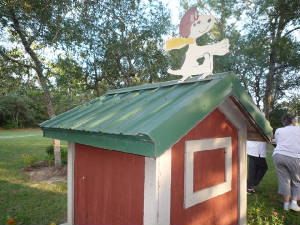
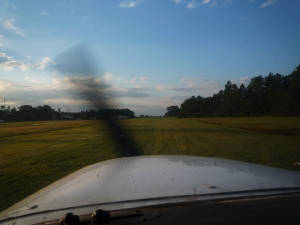
I turned around and noticed someone in a golf cart drive right up to the edge of the runway. That usually means “Follow me”, so I did just that. He escorted me to a nice spot to park my plane in front of a cute Acadian house with rocking chairs on the porch. One of the Mississippi 99s, the one who owned the airport, in fact, was waiting to drive me to Keesler Air Force Base (KBIX) to meet the other 99s who had flown and driven in the night before. We had to send in our information a week in advance to get passes to drive into the base. We were escorted to a parking lot next to one of many huge buildings. The base seemed to go on forever, the grounds were very clean and manicured as you would expect at a military base. We were a large group of 44 women (44 99s, to be exact or to confuse you, whatever the case may be) and a few brave men who could somehow deal with the estrogen overload. We piled into a presentation room where Major Kait Woods, a member of the Hurricane Hunter squadron (http://www.hurricanehunters.com/), was waiting to show us a slideshow and explain the airplane and their missions before we went outside to the flight line to see the airplane. I actually got a little choked up (no one saw that!) when I gazed longingly at a picture looking out the window of the C-130 flying through a storm. The Hurricane Hunter squadron flies the model WC-130J, the most noticeable difference from the normal C-130 being that the J model has six-bladed props versus the four-bladed props in non-J models. They often fly at 500-1,500 feet above the water while they observe the sea state to determine the rotation of a storm. In hurricanes that are Category 3 and higher, they will penetrate the storm at 10,000 feet because at that altitude, there is no icing and less lightning formation. Their flight pattern looks like an “X”, and each leg of the X is 105 nautical miles (NM). They fly four penetrations per mission. She said the eye of a hurricane can be anywhere from 3 to 30 NM wide! They drop these small tubes called “dropsondes” that transmit data in real-time to the base – temperature, dew point, and pressure – to give a vertical profile of the storm, and they continue transmitting until they hit the water when the saltwater breaks a seal on the casing, and the water getting into it stops the transmissions. Major Woods pointed out how important it is to understand the movement of hurricanes because it costs an average of one million dollars per square mile that needs to be evacuated. That’s a good enough reason! During the winter, when there are thankfully no hurricanes for them to hunt, they fly presidential support by transporting vehicles and other supplies, they conduct air medical training missions, and they participate in great projects like Wounded Warriors (http://www.woundedwarriorproject.org/). This was all fascinating, really I was learning a lot, but I couldn’t contain my excitement and wanted to go touch the airplane. Major Woods warned us not to walk past a red line painted on the ground once we exited the building to get to the flight line or the base security would come to have a word with us. I stood with my toe on the red line like I was waiting for a race gun to go off until our escort led us out to the airplane. The inside of a C-130 is, of course, immense. You can drive cars and tanks into it. And you can fit 44 eager 99s into it with room to spare. It’s bigger than my first many apartments. I really wanted to strap myself in and refuse to leave, but I showed a lot of self-control and got out when the tour was over.

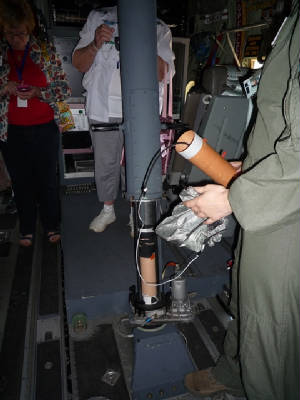
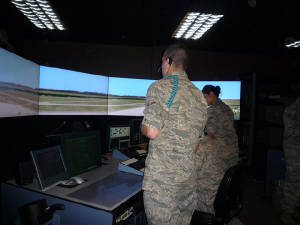
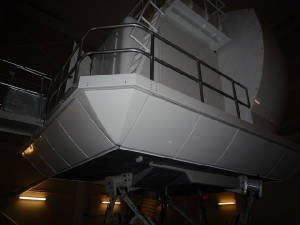
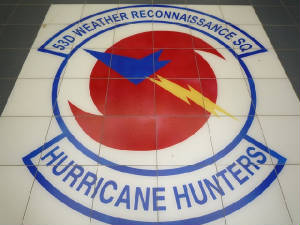
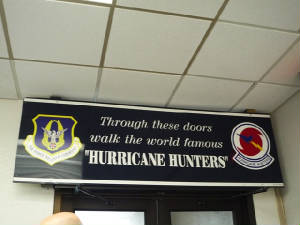
We went back inside where they said we could buy t-shirts if we wanted. They said since they hadn’t been going to as many airshows since the government sequestration hit, they weren’t making as much money since the t-shirt sales at airshows were a pretty big money maker. One of the 99s assured them that we’d make up for at least a few missed airshows. The t-shirts were stored in a small closet off the main hall, and when they opened that door for a bunch of women who are crazy about all things aviation, I swear it was like hand-to-hand combat trying to get anywhere near the closet. I was only about five people back when they opened the door, and I’m telling you a 70-something-year-old lady elbowed her way past me. I patiently waited my turn and then squeezed into one side of the closet. It was like being at a bazaar in Marrakesh with women yelling out “What size is that one?” “How much is that one?” “Can you throw me one of those?” It’s a good thing I liked the shirts they had on that side of the closet because there was no way I could change position once inside. Trying one on for size was like trying to move around in a subway during rush hour in China. I put my money in the collection box and then dodged and weaved my way upstream through the crowd. From the looks of it, we probably just funded the next WC-130J they buy. Next, we went to another part of the base where they had the WC-130J simulator and got to climb inside it. Want to know how much just one WC-130J simulator costs? $30 million big ones. Looking up at the raised simulator (they are raised since they are full motion, so they need room to move), I thought “Hmm. So that’s what $30 million looks like.”
After the simulator, we drove to another building on the base where two officers met us outside. The man said that he was going to show us something even cooler than the C-130. They were about to give us a tour of the air traffic controller training facility. What? Did I just hear him right? Sir, no offense to you and your tin pushers. I mean, some of my best friends are tin pushers. But there simply ain’t no amount of air traffic controllers and their gizmos and wingdings that can equal anything near as cool as a WC-130J. Thank you very kindly for trying, though. Next, we headed over to Infinity Space Center near the Stennis International Airport for a self-guided tour of the space museum. It was geared more towards kids, but since we were acting like older kids today, that worked just fine.
My parents used to drive us over to Florida when my brother and I were kids to watch the space shuttle launches. I don’t remember them at all, but it stirs something inside me every time I see a video of a launch. The engineering needed to produce that kind of raw power is amazing. So I sat and watched the videos they had playing on a loop of launches and the building of a launchpad in the swamp. I stood on a scale that told me my weight on each planet in our solar system. I much prefer my weight on Pluto to the one here on Earth. Weren’t we all supposed to be living on the other planets by now? I think we need to restart that discussion just so I can weigh 1/5 of what I do here. We finished the day at Stennis Airport with a tour of the Aerojet Rocketdyne rocket engine assembly facility. We couldn’t take pictures there, but we got to walk around the assembly floor and see some engines in storage, one that our tour guide said was worth $1.6 billion! Hmm. So that’s what $1.6 billion looks like. It actually just looked like something big covered in plastic. It’s baffling what some pieces of metal stuck together cost. I guess the same goes for airplanes.
We headed back to Shade Tree Airport where it was bustling with the exact kind of activity you would expect at a grass runway: two Stearman taildraggers were giving rides, chairs were set up for an outdoor aviation movie night, and local pilots had brought all manner of food and drink to enjoy the evening with friends. Sadly, I had to leave to get back home for the reopening of the Lakefront Airport terminal building (more on that in a later post). I left with multiple requests to come back anytime. I love my friendly aviation community!
Saturday Business Meeting: While nothing could compare with the exciting events of Friday (I got my first ever ride in a Stearman that was equally as cool as everything else) we still had to complete the business portion of the program – after all, that is why we were supposed to be here. We had a great Chapter Chairs meeting talking about everything from soup to nuts in the Chapter events. It was a great opportunity for me, as Governor, to sit with our Chapter leaders and make sure we are all on the same page.
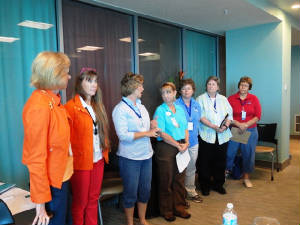
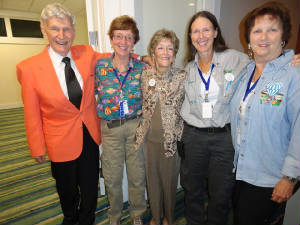
The business meeting followed. Tamra Sheffman gave me a set of “directional flares” which were clever – they are giant highlighter pens but gave me a great toy to use to “direct” our pilots as they migrated about the room. We had a full schedule covering topics such as our current membership count, Chapter reports, bylaws changes, AL SOS registration, and our IRS status report. We all enjoyed Cynthia Madsen giving her best “Mary Wunder imitation”. She left us all in stitches with the Endowment Fund report.
We learned about the International Scholarship Bank and discussed the future of our own Gann Memorial Scholarship plus upcoming Section meetings and the 2014 International Conference in New Orleans. When it was all through, we discovered we sprinted through the agenda with time to spare.
The remainder of the afternoon on our own was spent enjoying the sights of the Gulfport area and preparing for our evening banquet featuring Janet Green as our speaker. We were delighted that one of our own Mississippi Chapter members had such a rich life of aviation and travel. We were left awe struck and happy to make her acquaintance.
Thank you Mississippi Chapter for such a great weekend. We are looking forward to our visit to Charleston next!
